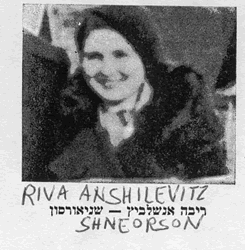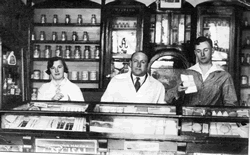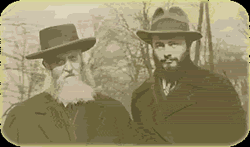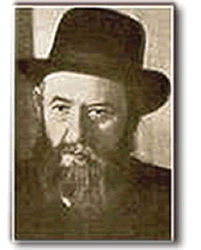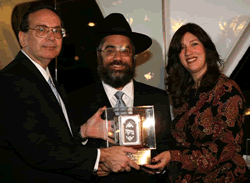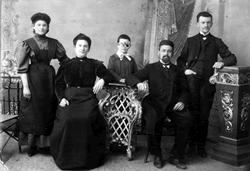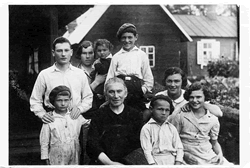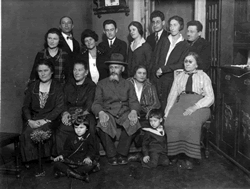#shn-5
Daniel Levitan, Rabbi Yossi Baitelman ( Ancestry from Dokshitz) and
his wife Chani ( Ancestry from the Shneirson family of Chabad.)
#shn-6
Boris (Benzion) Yakobinetz, Yakhna Moiseevna Schneerson, Leyba Schneerson, Tzetziliya (Tzilya) Mikhaylovna Schneerson, R' Mikhel Shmuel Schneerson, of Griva
#shn-7
Yakhna Moiseevna Schneerson, Mania Meierovna Schneerson, Movsha Israel Meierovich Schneerson, Dveira Meierovna Davidson, Sara Meierovna Schneerson
#shn-8
Yakhna Moiseevna Schneerson, R' Mikhel Shmuel Schneerson, of Griva, Musya Kopelevna Davidova, Kopel Shlomovich Zhuk-Kogan, Khana Freida Benzianovna Mikhel, Olga Tzalkovna (Savelievna) Kurgatnikova, Osher Alexandrovich Kurgatnikov, Rosya (Rosa) Tzalkovna (Savelievna) Zhuk-Kogan, Abram Birkengeim, Khaya Birkengeim, Tzetziliya (Tzilya) Mikhaylovna Schneerson, Boris Osherovich Kurgatnikov, Sophia Tulbowitsch, Boris (Benzion) Yakobinetz
#shn-9
Yakhna Moiseevna Schneerson (Berlin)
Gender:
Female
Birth:
1860
Vitebsk, Belarus
Death:
before December 05, 1941
Daugavpils, Latvia (killed in ghetto)
Immediate Family:
Daughter of Mosh? Zalmanovich Berlin and Dvora Berlin
Wife of R' Mikhel Shmuel Schneerson, of Griva
Mother of Meier Schneerson; Salman Schneerson; Leyba Schneerson; Tzetziliya (Tzilya) Mikhaylovna Schneerson and Boris (Benzion) Yakobinetz
Sister of Yerukham Ber Berlin; Khanna Karnibad; Musya Ganelina; Khaya Birkengeim; Mira Tulbowitsch and 2 others
#shn-10
Zalman Berlin
Birth:
estimate 1841
Immediate Family:
Father of Siskind Alexander Berlin; Binyamin Zalmanovich Berlin; Shimon Zalmanovich Berlin and Mosh? Zalmanovich Berlin
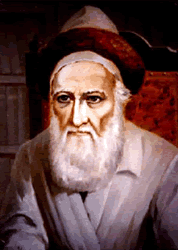
Rabbi Menachem Mendel Schneersohn (Schneerson), famed as the "Tzemach Tzedek" after his magnum opus on Talmudic law, was born on the eve of Rosh Hashana 5549 (1789), to Rabbi Shalom Schachne and Devora Leah. His maternal grandfather was Rabbi Schneur Zalman (Baruchovitch) of Liadi-Lyozna, founder of Chabad Chassidus, and popularly known as the "Alter Rebbe" (Old Rabbi), or simply as the "Rav." Two great works of Rabbi Schneur Zalman are Tanya and Shulchan Aruch, on Chassidus and Torah law respectively. Rabbi Menachem Mendel's father-in-law was his uncle Rabbi Dov-Ber Schneuri, the "Mitteler Rebbe," whom he succeeded as head of the Chabad Chassidim on Kislev 10, 5588 (1827 ), until his passing on Nissan 13, 5626 (1866) .
When Rabbi Menachem Mendel was fifteen, Rabbi Schneur Zalman instructed him to work with his uncle, Rabbi Moshe, in communal affairs. This was in addition to his responsibility to study all inquiries on Torah matters, and after discussion of the law with Rabbi Yehuda Leib of Yanovitch (Rabbi Schneur Zalman's brother and author of Sheris Yehuda), to submit responsa in outline to Rabbi Schneur Zalman.
After residing briefly in Haditch where Rabbi Schneur Zalman had been interred in 1813, Rabbi Menachem. Mendel settled in Lubavitch, Mogilev province, in 1814, with his father-in-law. He stipulated that no communal problems intrude on his studies. His assiduity in study was exceptional, 1 and he continued to examine all Torah inquiries received by Rabbi Dov-Ber. When Rabbi Dov-Ber approved, he would answer the letters. This regime lasted about twelve years.
1 "I generally studied eighteen hours daily, including five hours in writing; he wrote to his son.
In a supplement to Torah Or (N. Y. 1954, p. 285), Rabbi Joseph I. Schneersohn writes:
By the age of ten (Rabbi Menachem Mendel) had a swift and beautiful hand. He could write a page of thirty lines in five or six minutes. Every day he wrote for three hours, and to make up for Shabbos and Holy days, he wrote the following evening. Once his son complained about the excessive stringency of a teacher, R. Gershon. "Is that stringent?" Rabbi Menachem Mendel exclaimed. "It is nothing compared to the regimen I imposed on myself at the age of nine, regarding hours of study and writing."
In later years Rabbi Menachem Mendel attributed his success at the Rabbinical Commission of 1843 to three merits. One was the 32,000 hours he spent during thirty years in profound study of Rabbi Schneur Zalman's works, and the commentaries he wrote then twenty hours every week.
Rabbi Dov-Ber was accused1 in 1826 of subversive activities, and ordered to appear in Vitebsk. At this point Rabbi Menachem Mendel entered public life. His first undertaking was the organization of a committee, composed of people from various circles, to defend Rabbi Dov-Ber. He also laid t efforts on establishing farm colonies in Vitebsk and Minsk provinces; Mogilev boasted a great many colonies by that time.
1 While fleeing Napoleon's armies Rabbi Schneur Zalman died. All the family's possessions in Liadi were destroyed. Rabbi Dov-Ber was then in Kremenchug in Little Russia, and from there he went to settle in Lubavitch in White Russia. Chassidim en route provided him with means to establish himself in his new home. Upon his arrival however, he decided to distribute the funds to the needy, and wrote to a relative about forming a committee of three to supervise the allocation. In this letter he referred to a "considerable" sum.
Years later this letter came into the hands of the recipient's heir, as unscrupulous and vengeful enemy of the Rabbi. He harbored air implacable hatred of the Rabbi for some personal family "slight." He attempted to use this letter to blackmail the Rabbi, but the Rabbi refused to be intimidated by a perfectly innocent letter.
With some judicious doctoring, the figures in the letter, "three or four thousand rubles" became "one hundred and three or four thousand." This was indeed a "considerable" sum. What could be its purpose? And how did he gather such a sum on so short a journey? Simple. He was plotting a revolution! The money was destined for the Turks, who then ruled the Holy Land. The regular remittances to needy scholars there lent an air of credibility to the charges.
Other weird accusations were made concerning the dimensions of the Rabbis synagogue being similar to those of the Jerusalem Temple, and of course that meant that he intended to be King of Israel or something. The similarity to the charges leveled against Rabbi Schneur Zalman ( fn. 37) in 1798 is striking.
In the fall of 1826 the Rabbi was instructed to appear in Vitebsk, the provincial capital. This was done in a most respectful manner, through high-ranking officers and arrangements to suit the Rabbi. Hundreds accompanied him from Lubavitch, and at every village the elders met him with the traditional bread and salt. The honor and reverence accorded him by Jew and Gentile deeply impressed the officials.
Governor-General Chavanski, a harsh man who entertained little affection for the Rabbi, conducted the investigation. However, Dr. Heibenthal, Jan Lubomirski, and others interceded on his behalf. He was treated with dignity and later permitted to worship publicly, lecture on Chassidus, etc. He was officially informed that he was completely exonerated of all suspicion and released on Kislev 10, a festival among Chassidim ever since.
For details of the dramatic trip and investigation, see Hatomim II, Warsaw, 1935, p. 74 ff.
The Kherson farmers1 had demonstrated the feasibility of Jews' settling on farms. They prospered there, and many regularly gave tithes to charity, a portion to be distributed at the discretion of Rabbi Dov-Ber. The settlers in Vitebsk, Minsk, and Mogilev received aid from the reconstruction fund established by Rabbi Dov-Ber, and a large proportion of the loans had been repaid into the agriculture fund.
1 Chabad Rabbis were always concerned about the material welfare of Jews, not only about their spiritual condition. In order to alleviate their economic distress he encouraged farming, a previously unfamiliar occupation. To this end he persuaded the Government to allot land in Kherson province for Jewish settlers. He arranged for their settling, supplied them with the necessities, and spent a full summer with them at the time. ( Kuntres Umayon, New York, 1943, p. 14.)
Rabbi Dov-Ber's last three years, 1825-1827, were hard. Because of the depression the contributions for the families in the Holy Land1 were only one third of the required sum, and the debts were overwhelming. Rabbi Dov-Ber loaned money from the agriculture fund to complement the contributions.
1 About the year 1777, a group of Chassidim established a colony in the Holy Land under the leadership of Rabbi Menachem Mendel Vitebsker (Horodoker) -- for whom the Tzemach Tzedek was named -- and elder confrere of Rabbi Schneur Zalman.
Rabbi Menachem Mendel appointed a council of five senior Chassidim who would make the necessary decisions in communal problems. They were Rabbis Moshe Meisels1 of Vilna, Baruch Mordecai Eitinga2 of Bobroisk, Isaac 3 of Gomel, Hillel4 of Paritch, and Peretz5 of Beshenkovitch. Rabbi Hillel began making regular visits to the Kherson settlements in 1828, and would spend the three summer months there annually. Besides his influence on the settlers in regard to Torah and piety in the Chassidic tradition, he had a salutary erect on their personal conduct and brotherly relations with each other.
for the rest go to ; http://www.jewish-history.com/Chabad/haskalah1.html
The Chabad Heritage Series
presented by Rabbi Shloma Majeski; http://www.sichosinenglish.org/audio/heritage/
http://www.us-israel.org/jsource/biography/schneerson.html
Rabbi Menachem Mendel Schneerson, the leader -"the Rebbe"- of
the Lubavitch movement of Chassidic Judaism for forty four years, was
a paradoxical man. While he barely set foot outside his neighborhood during
his entire leadership, his influence was felt worldwide. While he was
considered one of the worlds foremost religious scholars, he was also
recognized as a brilliant scholar in mathematics and science. While he
appeared to be an Old World leader whose community was somewhat cloistered,
he was thoroughly knowledgeable about the modern world and reached out
enthusiastically to society at large, to Jew and non-Jew alike, encouraging
the pursuit of virtuousness education, and unity.Menachem Mendel Schneerson
was born on April 18, 1902 (the eleventh day of Nissan, 5662), in Nikolayev,
a town in the southern Ukraine. His father, Rabbi Levi Yitzchock Schneerson,
was a renowned scholar, his mother, Rebbitzen Chana Schneerson, was an
aristocratic women from a prestigious rabbinic family. He had two younger
brothers, Dovber and Yisroel aryeh Leib.. When Menachem Mendel was five
years old, the family moved to Yakaterinoslav, now Dnepropetrovsk, where
his father was appointed chief rabbi.From early childhood, Menachem Mendel
displayed prodigious mental acuity, leaving school for private tutoring.
By the time he reached bar mitzva, he was considered a Torah prodigy,
and during his teenage years, he immersed himself in the intricacies of
Torah study. In 1923, he met Rabbi Yosef Yitzchock Schneerson - then the
Lubavitcher Rebbe- who drew him into his inner circle giving him various
responsibilities; five years later, in Warsaw, he married the Rebbe's
second eldest daughter, Chaya Mushka (1901-1988).A short while later,
the couple moved to Berlin, where Rabbi Menachem Mendel had already begun
studying mathematics and science at the University of Berlin, Because
of the Nazi rise, the young Rabbi and his wife left Berlin in 1933 for
Paris, and he continued his studies at the Sorbonne. Primarily, however,
he immersed himself in prayer and religious study, and was referred to
by his father-in-law on various matters, including the preparation of
Lubavitch publications. He also served as his father-in-law's private
secretary and traveled on his behalf to visit various Jewish leaders in
Europe.When the Nazis occupied Paris, the couple was forced to escape
the city. On June 23, 1941 they arrived in New York, where Rabbi Yosef
Yitzchock Schneerson appointed his son-in-law head of Lubavitch's educational
arm, as well as the movements social-service organization and its publishing
house.In 1950, Rabbi Yosef Yitzchock passed away. Although Rabbi Menachem
Mendel was the obvious successor, he was initially reluctant to accept
the mantle of leadership. A year later he formally assumed the title of
Rebbe, explaining to members of the movement that while he would be devoted
to his work as leader, each man and women was ultimately responsible for
his or her own actions, and for his or her pursuit of G-dliness.The ensuing
forty-four years of the Rebbe's leadership saw Lubavitch grow from a small
movement nearly devastated by the Holocaust to a worldwide community of
200,000 members. The Rebbe, recognizing the unique needs of the current
generation and anticipating the societal needs of the coming decades,
began to establish education and outreach centers, offering social-service
programs and humanitarian aid to all people, regardless of religious affiliation
or background. He established a corps of Lubavitch emissaries (shluchim)
and sent them out to build Chabad - Lubavitch centers worldwide, to serve
the spiritual and material needs of the local communities. Today there
are more than fourteen hundred Chabad-Lubavitch institutions in thirty-five
countries on six continents.By blending his intense religious and secular
training with deep compassion and insight, the Rebbe quietly became a
leader to whom other leaders - those in politics, business, and religion
- turned for advice. Beginning in 1986, he would personally greet thousands
of visitors each Sunday, distributing dollar bills that were meant to
encourage the giving of charity; many people saved the dollar bills as
a memento of their visit with the Rebbe, a testament to being moved by
his presence.With the fall of communism and the miracles during the gulf
war, the Rebbe stated that these are heralding a time of peace and tranquillity
for all mankind, the time of Moshiach (messiah). To this end the Rebbe
placed much emphasis on the traditional Jewish teachings regarding the
time of Moshiach, placing great emphasis in the studying of these concepts.
The Rebbe also oft repeated the statement of our sages that through doing
just one good deed we can usher in the era of Moshiach. May it be speedily
in our days.In 1992, at the age of ninety, the Rebbe suffered a stroke;
he passed away two years later, on June 12, 1994. Shortly thereafter,
a bill was introduced in the U.S. House of Representatives by Congressmen
Charles Schumer, John Lewis, Newt Gingrich, and Jerry Lewis to bestow
on the Rebbe the Congressional Gold Medal. The bill passed both Houses
by unanimous consent, honoring the Rebbe for his "outstanding and
lasting contributions toward improvements in world education, morality,
and acts of charity".
Reb Shneur Zalman
(1745-1813) Reb Shneur Zalman was the founder of Chabad Chassidus, and
learned about Hasidism from Rabbi Dov Baer HaMaggid, leader of the Hasidic
movement. Under The Maggid, Reb Shneur Zalman wrote updated and profound
commentaries about the Shulchan Aruch. When the anti-Chassidic movement
was taking place in the mid-18th century, Reb Shneur Zalman went to Vilna
and attempted to speak to the Gaon of Vilna to try to reach some kind
of understanding between Chassidim and Misnagdim. Reb Shneur Zalman later
published the Tanya, which was accepted as the written law of Chabad Chassidus.Â
His ability to explain even the most complex issues of Torah made his
writings popular with Torah scholars everywhere. Reb Zalman had a vast
knowledge of mathematics and science as well. His son, Rabbi Shalom Dov
Baer Schneerson, became the leader of the Chassidic movement after Reb
Zalman’s death.
Rabbi Shalom Dov Baer Schneerson
http://www.ou.org/about/judaism/rabbis/dschneerson.htm
(1773-1827) The eldest son of Rabbi Shneur Zalman of Liady, who was the
founder of Chabad Chassidism and had suffered the full force of the anti-Chassidic
backlash, Reb Dov Baer became the leader of the Chabad dynasty after his
father's death in 1813. He moved the group to the town of Lubavitch in
Russia, after which the group became known. As a prolific writer, he expanded
on the mystical works of his father, and helped to further differentiate
the Chabad movement from other forms of Chassidism. Like his father, Reb
Dov Baer was imprisoned by the Russian authorities after allegations by
opponents, but was released soon after.
Excerpt From The Diary Of The Lubavitcher Rebbe, Shlita:
Monday, 16 Teves, 5688 [January 9, 1928], Riga.Today, I received by post
a gift from the estate of the late renowned chassid Reb Avraham Abba Persan
of Königsberg: some holy handwritten letters and chassidic
discourses.As soon as I arrived in Riga I began to inquire about the estate
of the gracious chassid mentioned above. Today (thank G-d), I have succeeded
in obtaining handwritten manuscripts by: my great-grandfather the holy
Rebbe the Tzemach Tzedek; the holy rabbis and tzaddikim, my great-uncles,
sons of the Tzemach Tzedek; my grandfather, the holy Rebbe Reb Yosef Yitzchak;[2]
my grandfather, the holy Rebbe Reb Shmuel,[3] and my saintly father the
holy Rebbe [Rashab]. A detailed list is attached.
Bibliographic Remarks
Wednesday, 25 Teves, 5688 [January 18, 1828].A letter written in the holy
handwriting of my saintly great-grandfather the Tzemach Tzedek. He wrote
it to the well-known chassidic magnate, Reb Zev Volf Vilenkes. The chassid
Reb Zev Volf once ran many business enterprises in the city of Vitebsk,
and owned a very large store. He was also involved in the forestry business.
The entire managerial staff of his commercial establishment was made up
of chassidim and men of good deeds.The chassidic magnate Reb Zev Volf
was very involved in communal affairs, and his name was familiar to the
most important civic leaders. He was very wise, and strong-willed. He
was frequently summoned to the government offices by the governor-general
[of Vitebsk], who would reprimand him and warn him about the conduct of
the Jews who resided in the city, or in the whole district.I first learned
of the existence of this letter from Reb Avraham Abba Persan during the
summer of 5661 [1901], when we happened to meet in Warsaw (as described
in my diary of 5661). He told me that the Rebbe the Tzemach Tzedek wrote
the letter in the year 5605 [1845], two years after his first summons
to a Rabbinical Convention in Petersburg in 1843 - 5603. The letter was
written in great secrecy, because they were very afraid of the government
officials. That was the fourth year that a high-ranking police official
had been stationed in Lubavitch (which was, after all, only a small hamlet
among other rural villages). His orders were to keep an eye on the activities
of the Rebbe and those who visited him.In the year 5602 [1842], the governor-general
of Vitebsk was informed - by Yisrael Yosef, the snatcher of Bichev - that
my holy great-grandfather the Rebbe had sent the outstanding young scholar
Reb Aharon of Bilinycz as his agent to all communities in the counties
of Mohilev and Vitebsk. Most of the leaders of these communities were
chassidim. He instructed them that they were to expel the snatchers from
their midst and excommunicate them, for they had resumed their child snatching
after a two-year interruption.The governor of Vitebsk informed the Minister
of Internal Affairs about this, and for that reason the Rebbe was summoned
to Petersburg for the first time, during the summer of 5603. Their intention
was to indict him for high treason. But in order to disguise their intentions,
they resorted to a ruse, summoning three others in addition: the gaon
Reb Y. of Volozhin, Reb Y. Halperin, and the Maskil Betzalel Stern. The
proceedings of that Rabbinical convention are well known, and are recorded
elsewhere. From that time on, the government kept a closer watch over
the Rebbe the Tzemach Tzedek.All this did not affect the Rebbe, who simply
ignored it. He continued his practice of sending his emissaries to encourage
those who were in military service to observe the Torah and its mitzvos,
and he sent his agents to ransom the cantonists.[4] He also took part
in a plot to eradicate the snatchers. Alas, during the year 5605 a misfortune
occurred: the chassid Reb Chayim Yehoshua of Kalisk was caught red-handed,
ransoming a few cantonists for a large sum of money in the village of
Kastoreve, near Kazan, in central Russia.The present letter was sent by
my great-grandfather, the Rebbe the Tzemach Tzedek, to the chassid Reb
Zev Volf. It refers to the matter of Reb Chayim Yehoshua, and his rescue.
I saw the letter in the possession of the chassid Reb Avraham Abba Persan,
when my family and I were living in Königsberg during the
summer of 5668 [1908], as mentioned in my diary.The following is what
Reb Avraham Abba related to me in connection with this holy letter:"When
we happened to meet in Warsaw during the summer of 5661, I told you about
this letter. It was written by the Rebbe the Tzemach Tzedek to my father-in-law's
father-in-law (that is how he always referred to his wife's maternal grandfather),
the chassid Reb Zev Volf Vilenkes. Now that we have it in our possession,
I will explain it word by word, exactly as I heard it and as [the commentary]
was transmitted to me."
A Collection Of Sacred Handwritten Letters By My Saintly Great-Grandfather,
The Rebbe The Tzemach Tzedek (Of Holy And Blessed Memory)
Translator's note: As mentioned previously, "The letter was written
in great secrecy, because they were very afraid of the government officials..."
Therefore, the letter does not mention Reb Chayim Yehoshua by name, nor
does it refer specifically to his arrest or rescue. On its surface, the
letter seems to be an appeal for financial assistance in behalf of "the
bearer," Reb Sender Yechiel. Thus, if the letter were to fall into
the wrong hands, it contains nothing to implicate the Tzemach Tzedek (or
anyone else) in a plot to rescue an accused traitor.
Links in the Chassidic Legacy: Letter From The Tzemach Tzedek With Remarks By The Previous Rebbe, And Excerpts From His Diary http://www.sichosinenglish.org/books/links-in-the-chassidic-legacy/15.htm
Name Residence Arrived Age
Meite Schnaierson Witebsk 1905 44
Eidel Schnaierson Witebsk 1905 18
Aron Schnaierson Witebsk 1905 10
 Basja Chneerson Elisavethgrad, Russia 1907
23
 Chassie Schneerson Koseletz, Russia 1913 17
 Chjene Schneerson Koseletz, Russia 1912 17
 Glava Schneerson Paris 1897 17
 Haim Schneerson Consple, Turkey 1923 33
 Chayeteige Shnairson Jerusalem, Palestine 1920
5
 Jacob Shnairson Jerusalem, Palestine 1920 25
 Sarah Shnairson Jerusalem, Palestine 1920 24
 Petro Szmorzun Olchowisce, Austria 1907 28
Perl Shnairzon Jerusalem, Syria 1914 19
Chaja Sznejer Wilna., Poland 1921 47
Ester Sznejer Oszek, Poland 1921 7
Etaz Szneier Monasterzysk, Poland 1921 61
Jacob Sznejer Wilna., Poland 1921 17
Leib Sznejer Wilna, Poland 1921 11
Lejzor Sznejer Oszek, Poland 1921 13
Marza Sznejer Sokolka, Poland 1921 19
Mina Szneier Monasterzysk, Poland 1921
Mordko Sznejer Oszek, Poland 1921 9
Sofa R. Sznejer Wilna., Poland 1921 22
David Shneierson Leeds, England 1907 20
Itte Shneier Bialistok, Grodno 1907 7
Meische Shneier Bialistok, Grodno 1907 3
Rosie Shneier Sadki 1904 18
Zire Shneier Bialistok, Grodno 1907 0
201 Nina Schnaier  1920
Annie Schnayolern...aw... Gitoin...w, Russia 1912 38
Channe Schnayslerm...wn Gitoin...w, Russia 1912 7
4Â Clisve Schnayslern...wn Gitoin...w, Russia 1912 9
Leiby Schnayslerm...wn Gitoin...w, Russia 1912 5
5Â Ester Schnayslern...wn Gitoin...w, Russia 1912 3
Moisclic Schnayslern...wn Gitoin...w, Russia 1912 11
Israel Schnayer Jaslowice, Austria 1907 19
Abram Schneyer Mogilew 1905 17
Bertha Schneyer Montreal, Canada 1913 25
14Â Braine Schneyer Putzajew Russia 1913 17
16Â Chaje Sure Schneyer Bachmacz, Russia 1914 49
17Â Charles H. Schneyer Montreal, Canada 1913 28
Edith Schneyer New York, N.Y. 1923 26
Feige Schneyer Lomza 1902 17
Feigel Schneyer Mako w 1903 18
Julius D. Schneyer Philadelphia, Pa. 1914 40
Gitel Schneyer Makow, Russia 1916 16
Hirsch Schneyer Bachmacz, Russia 1914 11
Kurt Schneyer  1895 17 61Â
Leibe Schneyer Bachmacz, Russia 1914 8
62Â Leibe Schneyersohn Russia 1904 18
Lois Schneyer Warschan 1892 28
 Margo Schneyer Eberswalde 1904 18
 Meier Schneyer Bachmacz, Russia 1914 6
Rubin Schneyer Makow, Russia 1916 60
William Schneyer  1918 21
 William Schneyer  1918 22
 William Schneyer  1918 22
 Wolf Schneyer Bachmacz, Russia 1914 50
Before leaving Russia, Chaya Mushka was engaged to marry the Rebbe, Rabbi
Menachem M. Schneerson.
The actual marriage was delayed until 1928, when, on the 14th day of Kislev,
their marriage was celebrated in Warsaw, Poland.
On the day preceding the wedding, thousands of Jews flocked to the railway
station in Warsaw to welcome her father and his family. During the course
of the day, a multitude of Chasidim, hailing from all of Poland, Lithuania,
and Russia, arrived in the capital.
At eight o'clock that evening, in the presence of the students of the
Yeshiva Tomchei T'mimim, her father celebrated the meal of the "chosson
mohl." In the middle of the meal her father delivered a ma'amar [chasidic
discourse]. Midnight came and went, and the meal was still in progress.
Her father expressed his desire to rejoice with the Yeshiva students,
and they at once formed a circle, in the center of which he danced a good
while.
The next day, the 14th of Kislev, at five in the evening, the "kabbalat
panim" began. Ushers were placed at the entrance of the Yeshiva,
and only guests with official invitations were allowed to enter. Thousands
of people surrounded the building and there simply wasn't enough room
for them all.
Hundreds of miles away, in Russia, in Dnepropetrovsk, (Yekatrinoslav),
another wedding celebration was taking place. The Rebbe's parents, Rabbi
Levi Yitzchak and Rebbetzin Chana, unable to attend in person, organized
a festive meal and farbrengen in their own house, to which hundreds of
local Jews flocked.
go to http://www.kehotonline.com/rebbetzin/marriage.html for the rest
to America on the ninth of Adar II 5700 (March 20, 1940), after miraculously
escaping from Nazi-occupied Poland. For six months he stayed at the Greystone
Hotel in Manhattan, NY where he had a suite that was used as a Shul in
addition to his living quarters.Finally, on the 5th of Av, a fitting residence
was located, and negotiations were started to purchase the building at
770 Eastern Parkway. A week later on Friday, 12 days in Av, the purchase
was completed, and the Rebbe was given the keys. A few days later the
Rebbe came to 770 and prayed Mincha and Maariv there. He then said, "The
One Above should allow it to be a permanent dwelling for the soul, for
Torah study and for prayer services, but a temporary dwelling for living
purposes. For very soon we should merit to be in the Holy Land with Moshiach
to read the rest go to; http://www.770live.org/Eng770/770history1.asp
The earliest Sneirsons have been traced to various shtetls in Lithuania and Latvia in the mid 1800's, including the following in Lithuania: Kupishok (Kupiskis), Salat (Salociai, Salat, Salatas, or Salaty), and Bauska, Latvia. To the right is a photograph of the Kupishok Marketplace, taken in 1912. ORIGINS OF THE NAMEThe Sneirson name has been spelled in many ways. In Lithuania, the name has been listed in a document as "Snejersonas." On arrival in the U.S., the first Sneirsons spelled the last name as "Sneierson," which later evolved into two branches of the family: the SNEIRSONS and the SNIERSONS. Other possible variations of the spelling might include the following: Sneirson Snierson Sneierson Schneerson Shneerson Schneierson Shneierson Shneourson Schneurson Schneourson Schneyerson Shneyerson Shneorson Shneiorson Shnieorson Schneorson Sznierson Schneourson Snejerson Shneursohn Snerson Snearson Sznejerson Szneerson Shneurson Schneurson Shneurson Schneursohn From: Encyclopedia Judaica, Keter Publishing House, Jerusalem:
SCHNEURSOHN (SCHNEERSON, SHNEURSON)
This is a patronymic of the Hebrew name "Schneur." (Some of the Schneersohns claim descent from the family of Hasidic leaders who were descendants of the Zaddik, Shneur Zalman of Lyady, the founder of Habad Hasidism, popularly known as Lubavich).
Jews used patronyms as a means of personal identification long before its comparatively recent use in the formation of hereditary surnames. The Talmud itself is a rich source for patrynomics, illustrating the fact that these were so common that it was necessary to distinguish names from one other by using relationships other than the straightforward "son of" such as "son-in-law," "brother-in-law," etc.
Most Jewish patronymics which have survived into modern Sephardi and Oriental Jews borrowed extensively from their Arab neighbours, while Ahkenazi Jews often translated Hebrew names into Yiddish and the vernacular, or used vernacular suffixes on the Hebrew name to indicate the patronymic.
One of the peculiarities of European Jewish onomastics is the unusually high proportion of metronymic surnames, which can be explained by the important place accorded to the mother in Jewish law. The smaller proportion of surnames based on the wife's name is also fairly unique to the Jewish people.
The most common signs indicating patrynomics are the prefixes "Ben" and "Bar" (Hebrew), "Ibn" (Arabic), and "Ou" (Berber), the suffixes "sohn" (German) or "s, es, is, ic, son, zon, el, and kind/kin/lin" (Yiddish, the latter mainly found in metronymics). Many Eastern European Jewish patronymics can be identified by the suffixes "ovitch, ov, off, eff, in , ko, ka. cik, and kin."
From: Nahum Goldmann Museum of the Jewish Diaspora:
SCHNEURSOHN, SCHNEURSON
Many Jewish family names are deeply embedded in legend and history.
Schneur is a German variant of the Hebrew Shneo(u)r, and Schneurso(h)n is the German/Yiddish equivalent of Ben Sheneor.
Shnei is the Hebrew for two, and or means light. The meaning of Shneo(u)r and similar names is two lights or two lamps.
Light is the primal element of creation in all ancient cosmologies. In the Bible, it is the first creation of G-d (Gen.1.2-3). In Rabbinical literature, it also symbolizes the Torah, the soul and wisdom.
One story explains Shneo(u)r as the name give to a baby orphaned of both parents in the hope that their two souls, or two lights, would watch over it. Another relates that when a husband and wife wanted to name their new son after their father, they called him Sheneor, that is two lights, because both grandfathers had borne names meaning light: one had been Meir and the other Uri.
Ben Sheneor, meaning the son of two lights, is documented as a family name with the 12th/13th-century Rabbi and Tosafist, Samuel Ben Sheneor of Evreux, France. Seneor in 15th-century Spain, and Sheneor in 15th-century Holland. Schneur is recorded in 1545, Schneor in 1635, Schnepf in 1690, and Schneer in 1692. Schnerph is found in 1700, Schneyer in 1757, and Schnerb and Schnerf in 1784. ORIGINS IN AMERICAThe Sneierson Immigrants
1. George Sneierson
George Sneierson was born on July 10th, 1870 in Riga, Latvia, to Hiram and Mary Sneierson. He emigrated to Boston, Massachusetts on or about May 5, 1888, and settled in Manchester in Hillsborough County, New Hampshire. He petitioned for naturalization in May of 1894. Leon Saidel and Kosriel Nunas of Manchester were his witnesses.
to read the rest go to; http://home.attbi.com/~sneirson/origins.html
Kurenets, Belarus
... Shneorson (the pharmacist) his wife, their son Liyona, the son's wife,
Riva nee Anzelevich and their daughter, – were murdered
ten months after the day of slaughter when the Jews in the area were killed.
Since the German needed a pharmacist they kept the family alive. They
helped many Jews with their escape. They were in touch with the Russian
partisans and gave them information. They were told by the partisans to
stay in Kurenitz for a little longer and then they would be helped with
their escape... The German found out that they are helping the Jews and
the partisans and killed them.
One son survived.
The Contemporary Jewish Documentation
Centre ("CJDC") project was the dream of Itzhak Shneorson, a
Parisian blessed with a sense for history, who early in the Second World
War began documenting the Nazi horrors. On returning to Paris after the
war, he decided to erect a monument in memory of the murdered Jews, turning
to Jewish Auschwitz survivor, architect Alexander Frasiz. He proposed
a building to house Shneorson's documentation, including the Gestapo archive
seized in Paris after falling from a fleeing Nazi truck.
http://www.aiq.co.il/pages/articles/45/shoah.html
Unpublished sections of Sefer Vitebsk Shneorson Mordechai, rav 3
Shneorson Mordechai, rav 4
Shneorson Mordechai, rav 5
Shneorson Yehuda Lev, rav 5
Shiri SHNEORSON, PhD Student, StanfordUniversity GSB.
Well done to Gil Shneorson who graduated through the AFF Program here
with us on March 26, 2002. We loved skydiving with you, and making friends
with both yourself and Yaron. We look forward to seeing you both again
soon.  Â
http://216.239.51.100/custom?q=cache:hEW3ULGPMKsC:www.ffadventures.com/albums/042102/042102/shneorson.html+%7C+Shneorson&hl=en&ie=UTF-8
Moshe Shneorson is the head and the mind of the company
Dr. Nona International Ltd. was established in Israel in 1994
Oren Shneorson
   Erez, M., Shneorson, Z. (1995).Â
Personality type and motivational charactoristics vs. professionals in
industry in the same occupational disipline. Journal of Vocational
Behaviors, 17, 95-105. Â Â Â
Minsk Vedomosti notices concerning the Shneersons of Lubavitch
Translation of two legal notices from the 2 April 1877 Minsk Vedomosti,
Page 154 in the bound volume, dealing with the finances of the
Shneerson family of Lubavitch:
1. Levik Boruch Shneerson
The Orsha District Police Board announces that, in accord with a decree
issued 17 January 1877 under Section 2089 Volume X Chapter II, for
nonpayment by Levik Boruch Shneerson, an Orsha residents who belongs
to the Lubavitch Hebrew community, of a money loan issued 27 October
1859, with principal of 432 rubles 44.5 kopecks, interest of 180 rubles
18.75 kopecks, fines of 62 rubles 12.5 kopecks, capital under
(razsrochke??) from 1876 to 1879 96 rubles 9.75 kopecks, for a total of 818
rubles 90.25 kopecks, a public sale will be held of real estate belonging to
Shneerson, including a one-story wooden dwelling house with two rooms
lying in the Orsha District, fourth ward, in the town of Lubavitch, on landing
belonging to the sovereign town of Lubavitch, to the honorable
descendants of the citizen Ivan Firsan, who (deeded?) to the house and
courtyard 320 square 3.5-foot units of length, said property appraised at
462 rubles, (by law purchased at a price below appraisal/s'
predostavleniem prava pokupshcikam predlagat tzenu nizhe otzenki). The
sale will be held in the Orsha District Police Board offices 2 June 1877 in a
three-day special re-auction. Those who wish to buy the
aforesaid property can see documents on the terms of this sale at the
Police Board offices.
2. Shneer Nokhimov Shneerson
The Mogilev Gubernya Board announces that, because Orsha resident
Shneer Nokhimov Shneerson failed to pay a fire loan made by this
government board that was backed by a lien on his house, there will be a
sale of three-room wooden house with extensions and sheds
located in the Orsha District, in the town of Lubavitch, on
(vladelcheskoi owned?) land appraised at 1297 rubles. The sale will be
held 3 June 1877, with a statutory re-auction, under the appraisal.
Those who wish may see documents concerning the execution of this
notice and the terms of the sale, at 6 Stole 2 Gubernya Board branch, on
all government days.
